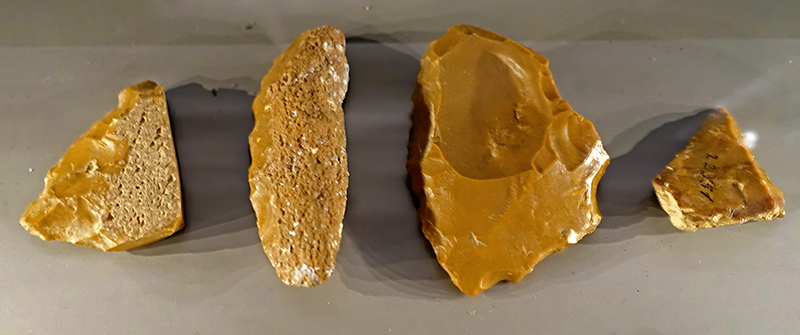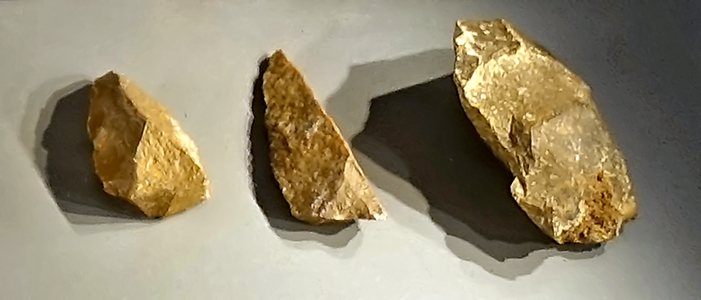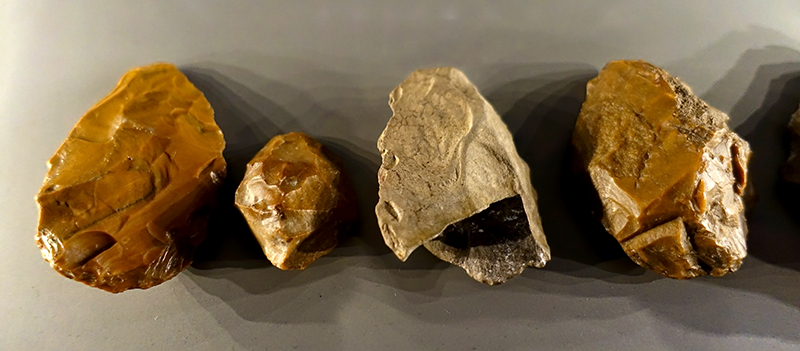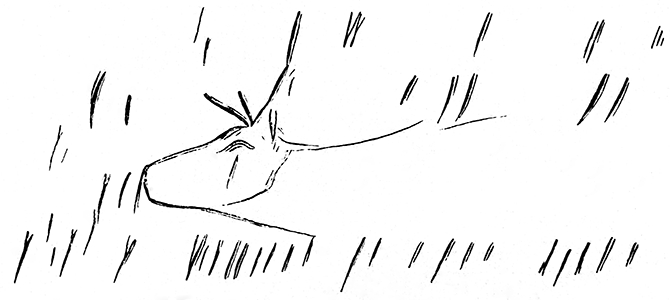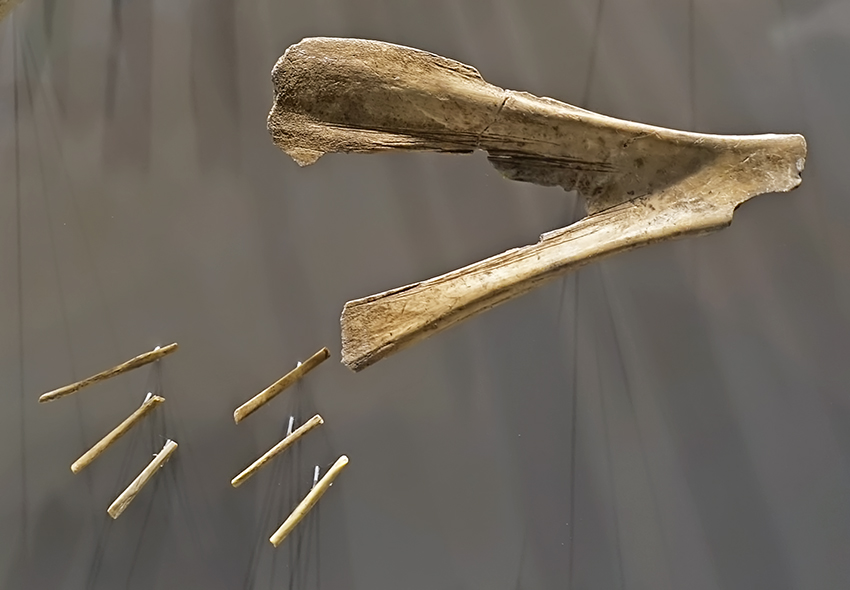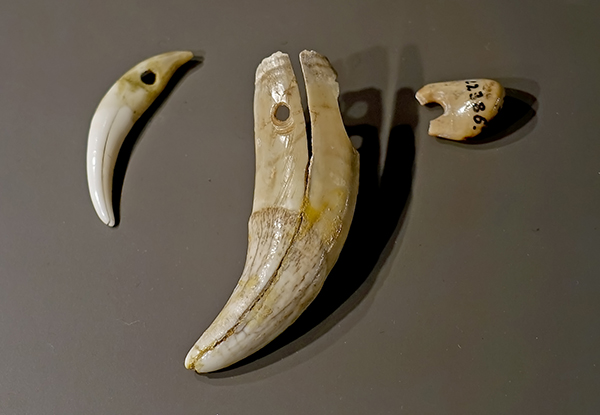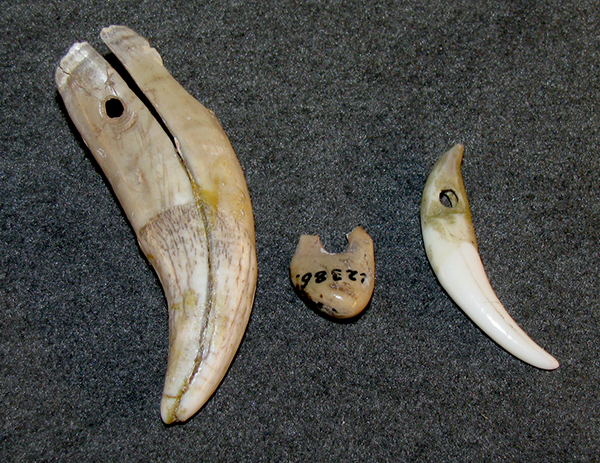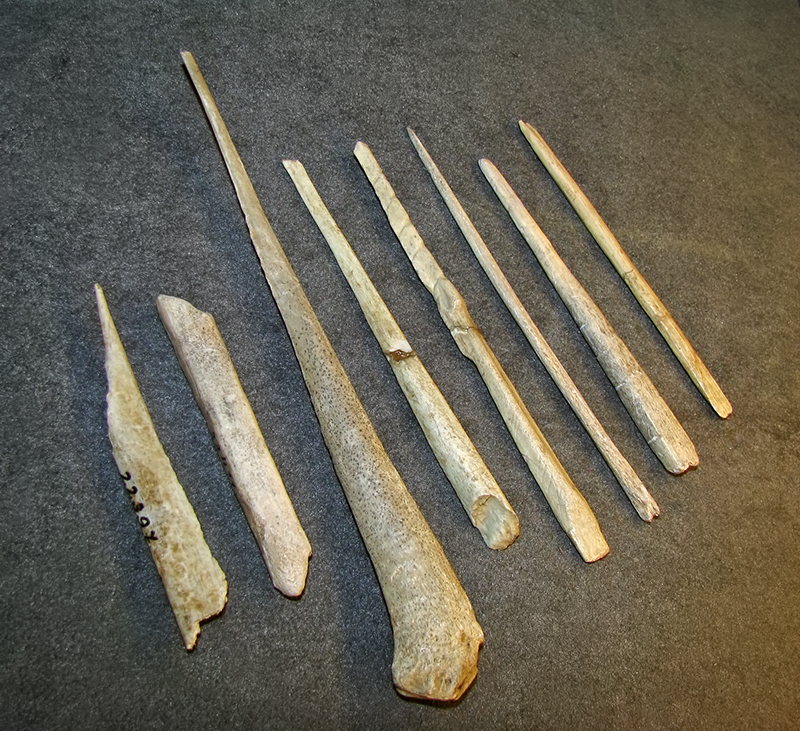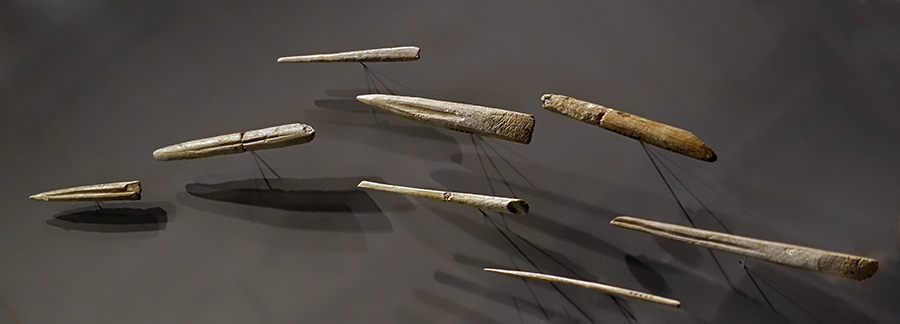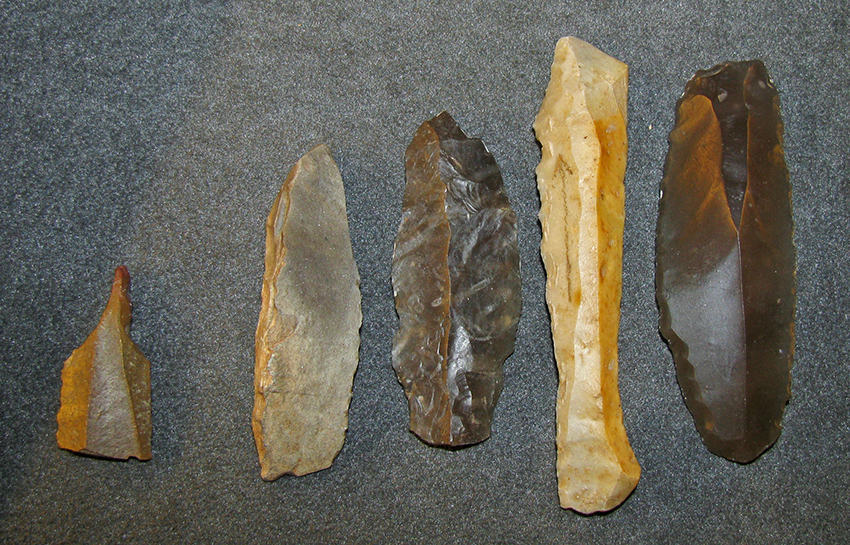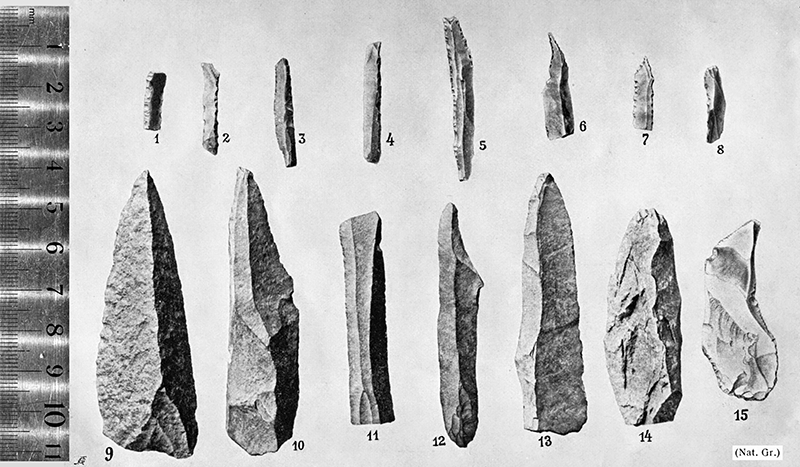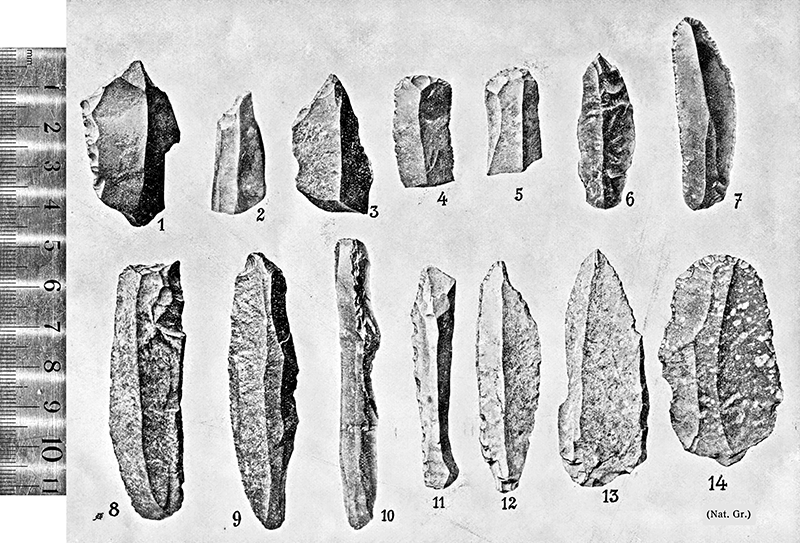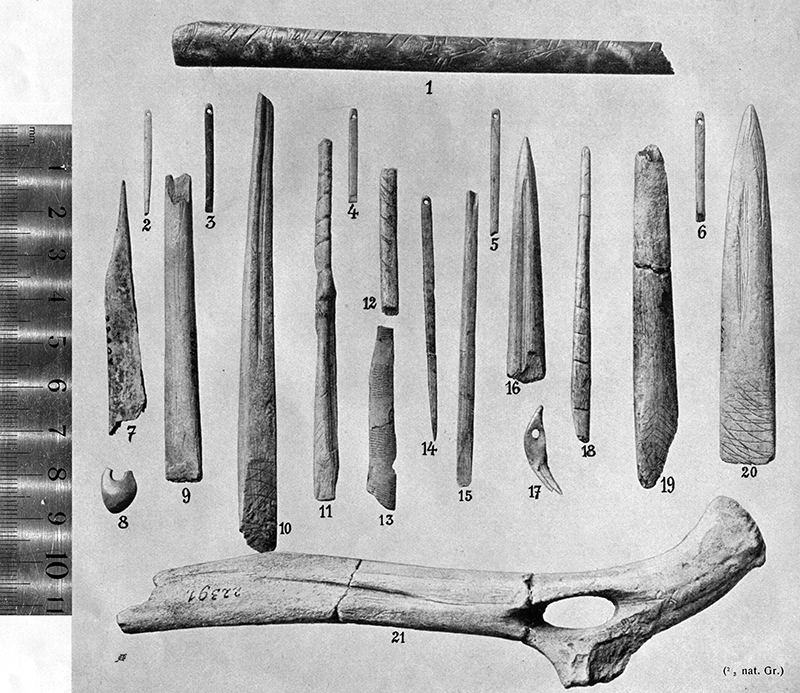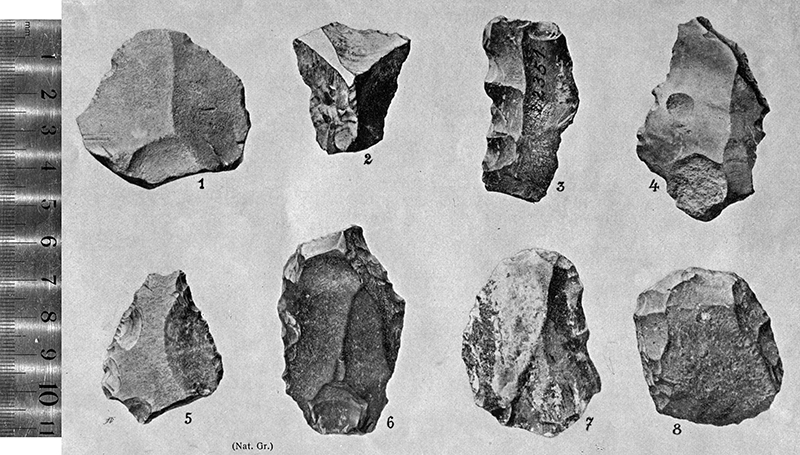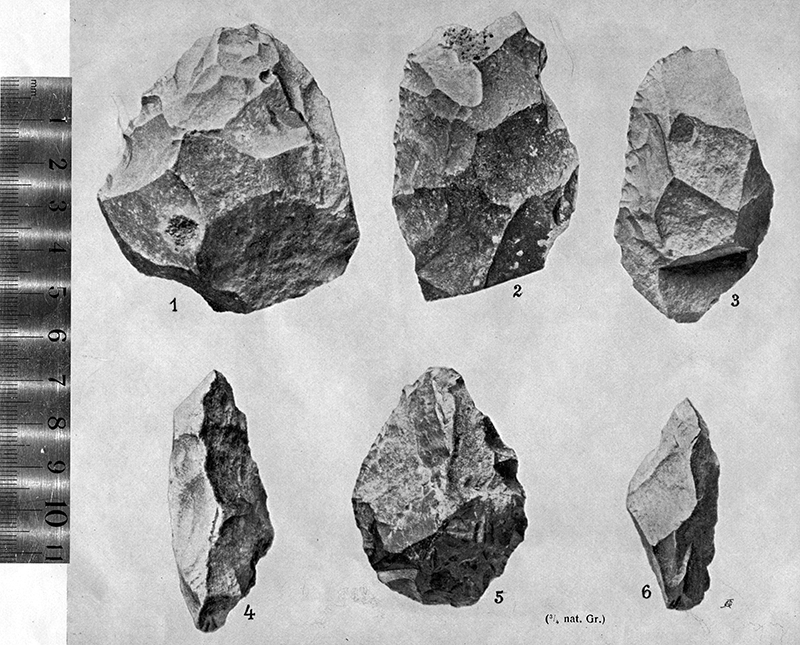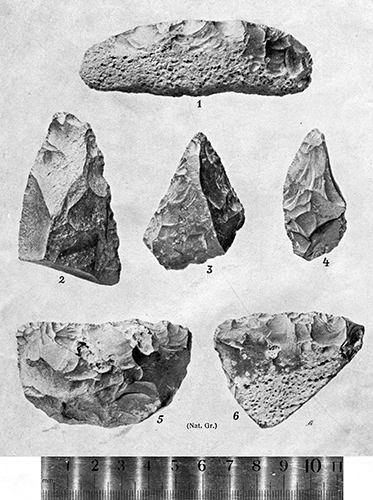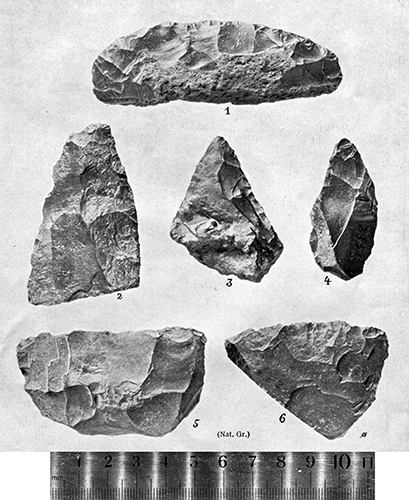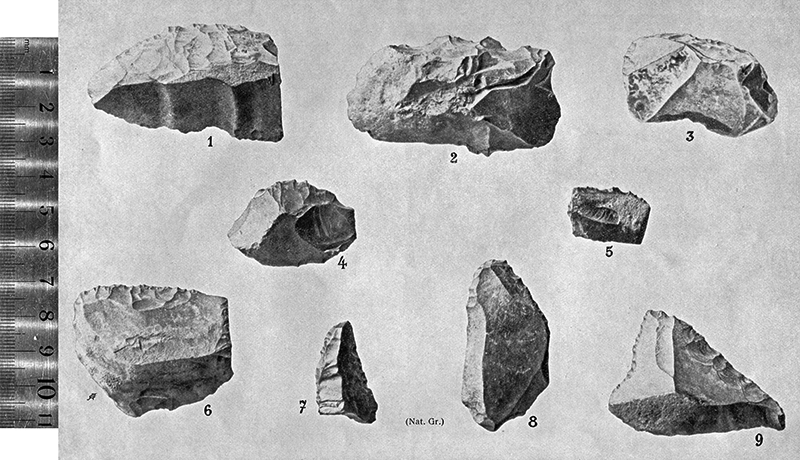Back to Don's Maps
 Mousterian (Neanderthal) Sites
Mousterian (Neanderthal) SitesGudenushöhle in Lower Austria - a Neanderthal site
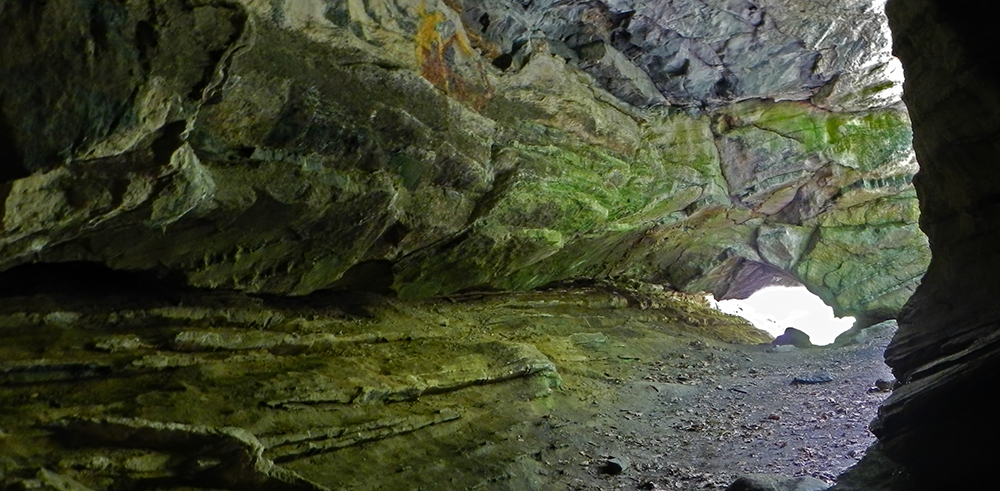
Gudenushöhle
Photo: Schurdl
Permission: Creative Commons Attribution-Share Alike 3.0 Unported license
Location: 48° 26′ 48.08″ N, 15° 23′ 44.74″ E
The stone tools below come from the Gudenushöhle cave, and were made by Neanderthals. Sadly, all records of the early excavation work carried out there have been lost. Typical tools discovered have made it possible to attribute the older layer to the Neanderthals, and the more recent layer to modern humans.
The Gudenus cave is situated 20 km northwest of the city of Krems, in the valley of the Little Krems, not far from Willendorf, in Lower Austria. The site is close to the River Danube. The cave is 22 m long with a width of 2 to 3 m and is situated 7.5 m above the level of the stream.
The archaeological deposit has yielded bones of numerous animals, including Woolly mammoth, Woolly rhinoceros, Aurochs, Chamois, Reindeer, and Red deer. Human artefacts include numerous flint implements beginning with the Mousterian (i.e. Neanderthals) of the Middle Palaeolithic, although there is no certainty as to the dating. ( Note, however, that Ackerl (2009) puts it at around 90 000 BP - Don )
There is also an Upper Palaeolithic, Magdalenian, assemblage including an engraved reindeer bone, and a fragment of a bone flute dated to about 18 000 – 12 000 BP.
Text above from Wikipedia.
Artefacts from Gudenushöhle, Mousterian, 100 000 BP - 40 000 BP.
These are scrapers, with the second from the left having a dentate edge.
Photo: Don Hitchcock 2018
Source: Original, Natural History Museum Vienna, Naturhistorisches Museum Wien
Artefacts from Gudenushöhle, Mousterian, 100 000 BP - 40 000 BP.
These are scrapers, with the artefact second from the right having been provided with a pronounced notch, probably to shape and smooth a bone point of a spear, or similar.
Photo: Don Hitchcock 2018
Source: Original, Natural History Museum Vienna, Naturhistorisches Museum Wien
Artefacts from Gudenushöhle, Mousterian, 100 000 BP - 40 000 BP.
Two Levallois blades on the left, and a Levallois core on the right.
( note that the blade in the centre of this group of three artefacts was identified by Obermaier und Breuil (1908) as being from the Magdalenian - Don )
Photo: Don Hitchcock 2018
Source: Original, Natural History Museum Vienna, Naturhistorisches Museum Wien
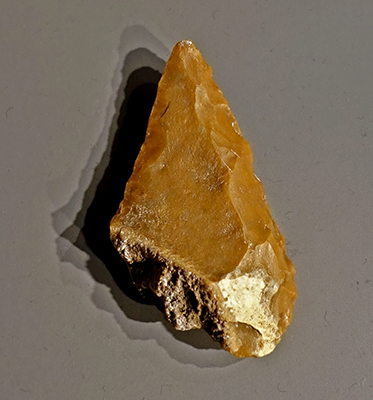
Artefact from Gudenushöhle, Mousterian, 100 000 BP - 40 000 BP.
Point.
Photo: Don Hitchcock 2018
Source: Original, Natural History Museum Vienna, Naturhistorisches Museum Wien
Artefacts from Gudenushöhle, Mousterian, 100 000 BP - 40 000 BP.
Handaxes.
Photo: Don Hitchcock 2018
Source: Original, Natural History Museum Vienna, Naturhistorisches Museum Wien
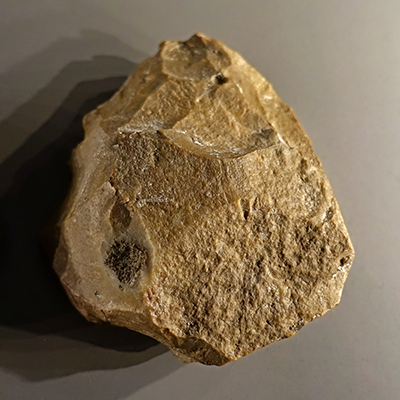
Handaxe from Gudenushöhle, Mousterian, 100 000 BP - 40 000 BP.
Photo: Don Hitchcock 2018
Source: Original, Natural History Museum Vienna, Naturhistorisches Museum Wien
A general comment on the development of lithic industries
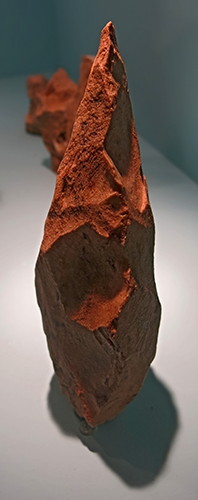
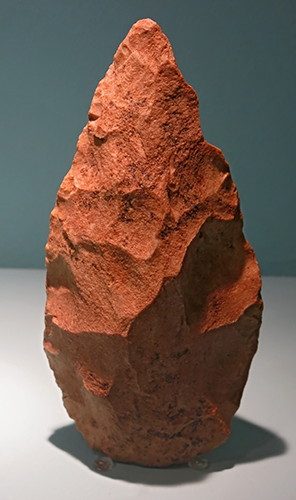
I am beginning to believe that some early, middle and late Palaeolithic communities treated their lithic industries - scrapers, hand axes, points and the like - as purely utilitarian, and spent only enough time on them as was necessary for a functional tool. Gudenushöhle and La Quina come to mind.
Others, such as the culture from Hochdahl, Stadt Erkrath, Kreis Mettmann, which existed circa 500 000 BP, which made this beautiful and well made quartzite hand axe, spent an inordinate amount of time on scrapers and hand axes and points in order to make them as beautiful and symmetrical and sharp as possible, and as a matter of pride in workmanship.
Photo and text: Don Hitchcock 2015
Source: LVR-Landesmuseum Bonn, Germany

We tend to think of human endeavours such as the creation of tools as a process of gradual improvement over the centuries and millenia, and in some cases this is true. The standard of flint tools reached its zenith in the Solutrean, circa 20 000 years ago, to the point where the tools were so thin and so long and delicate that they could not have been used for any worthwhile purpose - they became status objects.
As just one example, this Solutrean laurel leaf blade of prodigious length/width ratio from Le Placard is a demonstration of the skill of a master knapper.
That's not a knife - this is a knife!
Photo and text: Don Hitchcock 2014
Source: Original, Musée d'Archeologie Nationale et Domaine, St-Germain-en-Laye
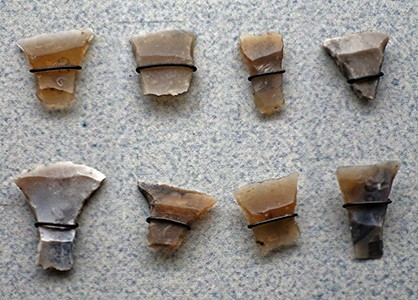
But the Solutrean was the peak of skill and invention in lithic industries, for the most part. After that, knappers became much more pragmatic in their choices of types of tool made.
In general, we can say that tools became smaller and more economical in terms of the skill, material and time expended, with the rise of the use of microblades, which were much better in bringing down prey because of the trauma they caused to the animal's body, and hundreds could be made in a short time from a very small amount of good quality flint.
The typical transverse Ertebølle arrowhead (7 300 BP to 5 950 BP) shown at left was designed to produce a large wound inside the body and thus cause an immediate substantial internal loss of blood, causing the animal to drop quickly, so that the hunters could avoid the situation that they hit the animal, yet it runs away with the arrow and lays down to die elsewhere.
Photo and text: Don Hitchcock 2018
Source: Original, Museum für Archäologie Schloss Gottorf
Additional text on the Ertebølle arrowheads adapted in part from: Sunyol (circa 2009) and http://prehistorics-uk.blogspot.com/2013/02/petit-tranchet-transverse-arrowheads.html
Dozens of perfectly useable microblades could be made in just a few minutes by making several simple small blades, sharp on both sides, and then breaking them into trapeziums, first from one side, then the other. However, even in this case, many hunters spent a good deal of time and effort in making the blades subtly better for their purpose, as in the image above. Humans in general have a desire to do the best work they possibly can.
The diminution in size was even the case with bone tools, with the superb barbed harpoons of the Magdalenian giving way to the smaller and just as effective Mas d'Azil harpoons, which required less material and time and skill to make.
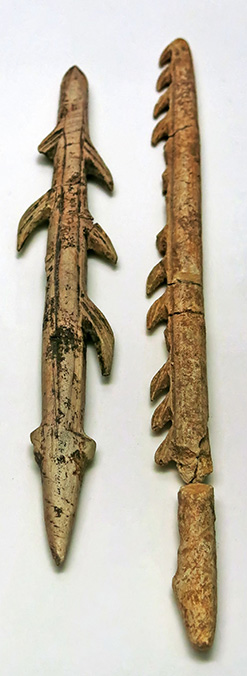
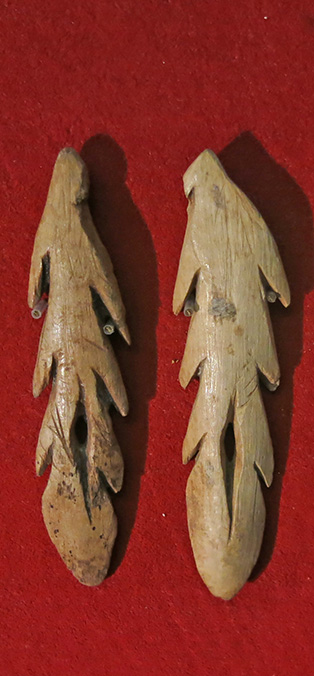
The diminution in size was even the case with bone tools, with the superb barbed harpoons of the Magdalenian giving way to the smaller and just as effective Mas d'Azil harpoons, which required less material and time and skill to make.
(left) Magdelanian harpoons from Laussel. The harpoon on the right has a length of 225 mm.
(right) Later Azilian harpoons from Mas d'Azil, circa 120 mm in length.
Photo and text: Don Hitchcock 2015
Source (left): Originals, display at Musée d'Aquitaine à Bordeaux
Source (right): Originals, La Salle Piette, Musée d'Archeologie Nationale et Domaine, St-Germain-en-Laye
Upper Palaeolithic Layers of Gudenushöhle
Magdalenian bone tools.
Gudenushöhle near Hartenstein, upper layer.
Nöhagen, VB Krems, Lower Austria.
Late Upper Palaeolithic, Magdalenian, circa 14 000 BP
Weapons and tools made of bone and antler are rather frequent in the upper layer of the Gudenushöhle. The head of a reindeer engraved on the radius of an eagle is the only example of Magdalenian art in Austria.
Borers and burins were used for carving. Bone needles indicate the high standard of clothing.
Photo: Don Hitchcock 2008
Source and text: Original, Natural History Museum Vienna, Naturhistorisches Museum Wien
Ulna of an eagle with the engraved head of a reindeer, used as a needle case.
This is the only Palaeolithic figural decoration known from Austria.
Gudenushöhle, Magdalenian, circa 14 000 BP.
It is number 1 in Plate 3 below, from Obermaier und Breuil (1908).
Photo: Don Hitchcock 2018
Source: Museum of Natural History, Vienna
Partially 'unrolled' reproduction of an engraving on the needlecase from the Gudenushöhle shown in the image above, from the Magdalenian deposits.
Photo: Obermaier und Breuil (1908)
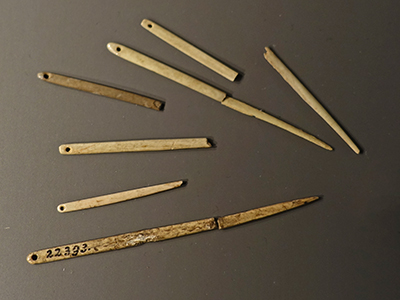
Needles from Gudenushöhle, Magdalenian, circa 14 000 BP.
Photo: Don Hitchcock 2018
Source: Museum of Natural History, Vienna
Gudenushöhle, Magdalenian, circa 14 000 BP.
Shoulder blades provide ideal and abundant material for needles, and are thin and strong.
Photo: Don Hitchcock 2018
Source: Museum of Natural History, Vienna
Bird bone with decorative engravings from Gudenushöhle, Magdalenian, circa 14 000 BP.
This is number 13 in Plate 3 below, from Obermaier und Breuil (1908).
Photo: Don Hitchcock 2018
Source: Museum of Natural History, Vienna
From right to left in the lower photo, a fox tooth, a deer tooth, and what appears to be a cave bear tooth, all pierced to be used as pendants.
Late Upper Palaeolithic, Magdalenian, circa 14 000 BP
Photo: Don Hitchcock 2018, 2008
Source and text: Original, Natural History Museum Vienna, Naturhistorisches Museum Wien
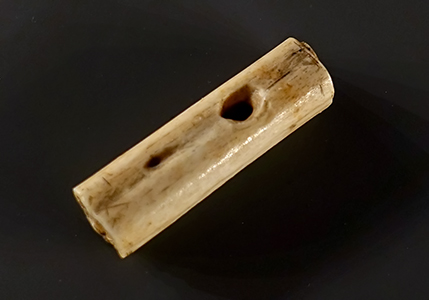
Whistle from Gudenushöhle, Magdalenian, circa 14 000 BP.
Photo: Don Hitchcock 2018
Source: Museum of Natural History, Vienna

Pierced baton of reindeer antler from Gudenushöhle, Magdalenian, circa 14 000 BP.
One use proposed for these tools is that of straightening the shaft of a spear or dart. This one appears to have had a lot of hard use, the original round hole being severely crushed and distorted into an oval shape.
This is number 21 in Plate 3 below, from Obermaier und Breuil (1908).
Photo: Don Hitchcock 2018
Source: Museum of Natural History, Vienna
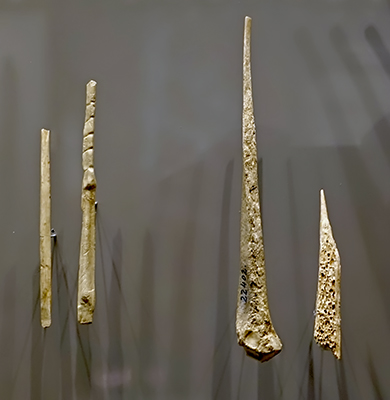
Tools from Gudenushöhle, Magdalenian, circa 14 000 BP.
On the right is a bone awl, number 7 in Plate 3 below, from Obermaier und Breuil (1908). It is on the far left of the image below this one.
On its left is another awl, not shown in plate 3, but is the other side of the awl third from the left in the image below this one.
On the far left is number 15 in plate 3, a spear head, shown on the far right of the image below this one.
Second left is number 11, a bone fragment with a decorative pattern, shown fourth from the right in the image below this one.
Photo: Don Hitchcock 2018
Source: Museum of Natural History, Vienna
( Most of these bone tools appear to be awls. Bone is good for such purposes, being long, strong, and giving a sharp and narrow point easily.
What is not clear, however, is why the tools needed to be so long. The fourth one from the right in this image even has a bevel at one end, to allow it to be attached to a handle - Don )
Late Upper Palaeolithic, Magdalenian, circa 14 000 BP
Photo: Don Hitchcock 2008
Source and text: Original, Natural History Museum Vienna, Naturhistorisches Museum Wien
Antler points from Gudenushöhle, Magdalenian, circa 14 000 BP.
Photo: Don Hitchcock 2018
Source: Museum of Natural History, Vienna
Gudenushöhle, Magdalenian, circa 14 000 BP.
Good flint and good workmanship combine here to make excellent tools.
Photo: Don Hitchcock 2018
Source: Museum of Natural History, Vienna
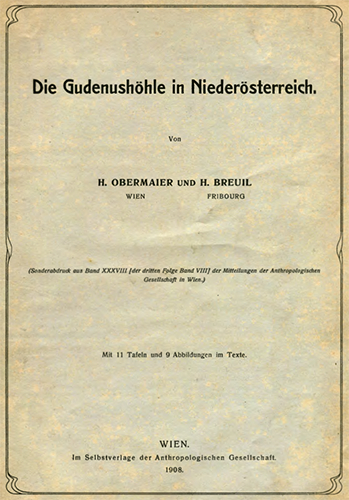
This is the most complete paper available from the time of the discovery of the Gudenushöhle. Click this link to see it.
It is from Obermaier und Breuil (1908)
I have put it into a pdf format, to make it available to others.
The Gudenushöhle
Obermaier und Breuil (1908)
The Gudenushohle in Lower Austria to the west of the town of Krems an der Donau has long been known as a Quaternary station.It is located in the valley of the 'little Krems', (der kleinen Krems) below the ruins of the castle of Hartenstein. ( it was used for target practice on 20th April 1945 by the US Air Force, but even in 1884 it was already described as a ruin - Don ).
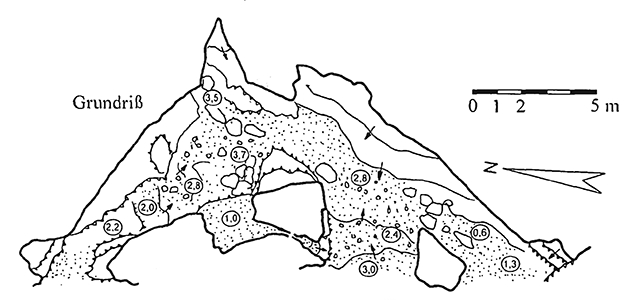
Plan of the Gudenushöhle
Photo: after Hartmann (1985)
Proximal source: Döppes (1997)
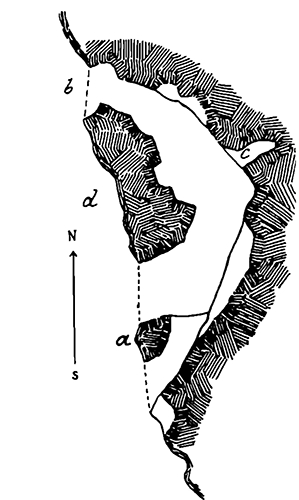
Plan of the Gudenushöhle
Photo: after Szombathy (1913)
Proximal source: Mayer et al. (1993)
The cave is 7.5 metres above the 'little Krems' river, and was first excavated in 1883-1884 by the engineer Ferdinand Brun and described by Father Leopold Hacker, whose report was supplemented by Jan Nepomuk Woldřich; Moriz Hoernes also paid tribute to the site.
This is a typical Kniehöhle, or passage cave with a bend in the middle, 22 metres long and 2-3 metres wide, and has two entrances, with the bend lying in the depths of the mountain.
The Magdalenians inhabited only the larger half of the cave, as well as the small forecourt which adjoins it.
The layers of the main cave were little disturbed by Hacker and distributed from top to bottom in the following arrangement:
I. Recent layer with Neolithic and Bronze Age inclusions 7 cm
2. Quaternary (Magdalenian) cultural history with hearths, artefacts, broken bones 28 cm.
3. Cave soil 6 cm
4. Cave clay with whole bones 26 cm
5. Cave clay without inclusions 28 cm
6. Sterile rippled sand 65 cm
7. Cave clay with weathering inclusions 22 cm
The following is the description of the same deposits, from Woldřich (1893)
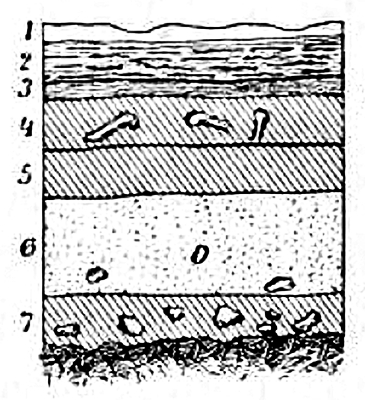
1. Recent deposits, consisting of earth, ash, stones and so on. 7 cm
2. Cultural history with artefacts and broken bones. 28 cm
3. Cave soil. 6 cm
4. Cave clay with whole, unrolled bone. 26 cm
5. Cave clay without inclusions. 28 cm
6. Rippled sand. 65 cm
7. Cave clay with boulder inclusions. 22 cm
Photo: Woldřich (1893)
A small adjoining chamber to the right of the main cave and located just 4.7 m above the level of the Kleinen Krems contained, according to Hacker (1884) in general, the same archaeological finds.
However, its layer sequence differs significantly from that of the main hollow, which has not been considered so far. It may be defined as follows:
I. Recent layer (black soil etc.) 4 cm
2. Sterile rippled sand 50 cm - 70 cm
3. Carboniferous layer with flint tools and bone splinters 5 mm
4. Cave clay 5 cm
5. Bone bearing layer with flint artefacts 5 mm
6. Sterile cave clay 1 cm - 3 cm
7. Bedrock.
The thick layer of corrugated (rippled) sand was located here above the Quaternary foundations, while it had been laid down below that in the main cave, but with exactly the same thickness. In the adjoining chamber it would have been possible to divide the cultural stratum, but this received no further attention.
Elsewhere in the paper, Obermaier und Breuil (1908) state that various floods forced the then settlers to repeatedly temporarily abandon the cave, possibly because of the periodic rise in level of the internal springs, which had washed out the fissure cave ( i.e. one formed by tectonic forces ), which itself was about 8 metres higher in altitude than the level of the former Krems River.
This last comment needs to be treated with caution in my opinion. To me it looks as though there never was any spring in the cave, but that there was periodic flooding of the Kleinen Krems which laid down the rippled sand (the Germans have a much more satisfactory word for it, ' wellsand ', meaning ' wave sand ', which is usually poorly translated as 'corrugated sand' by automatic translation websites) deposits referred to, and these floods were what rolled and abraded the bones and artefacts in the cave, an effect of flooding that I can attest to from personal experience.
The fact that the small adjoining chamber to the right of the main cave and located just 4.7 metres above the level of the Kleinen Krems had similar rippled sand deposits to those in the main cave, which is 7.5 metres above the Kleinen Krems, a good three metres above that, is significant.
I have spent a lot of time walking in similar situations in Australian and New Zealand river/gorge systems, and the periodic flooding of these rivers can easily produce this sort of deposition.
In addition, it is entirely possible that at that time the bed of the Kleinen Krems was much higher, possibly three metres or more, than it is now. This is certainly the case in the gorges east of Armidale NSW Australia, where the former (ice age) bed of streams is often obviously two or three metres above the present altitude, after the increase in precipitation at the end of the last ice age. The former stasis of the river bed during the ice ages at a time of low precipitation forms a series of almost flat disparate areas a few metres higher than the present stream beds in the gorges (whose river beds have been cut lower by increased rainfall after the end of the last ice age), which are ideal camping areas, keenly sought after by bushwalkers/hikers for overnight campsites. Apart from being ideal nearly flat but well drained, grassy tentsites, they are close to water, yet above any minor flooding because of a thunderstorm further up the river system during the night - Don )
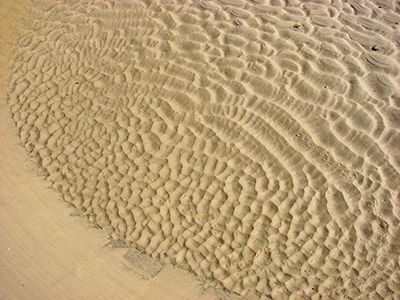
Rippled sand occurs when a flowing fluid moves over sand. This rippling is usually quite regular, but it can be quite chaotic in nature. The phenomenon occurs when either air or water flows over sand.
It was moving water in the case of Gudenushöhle, as is evidenced by the many examples of 'rolled' bones and artefacts found.
This photograph is of a polygonal pattern of recent ripple marks made by interference waves in a water pool at a river beach
Photo: Eurico Zimbres
Permission: Creative Commons Attribution-Share Alike 2.5 Generic license.
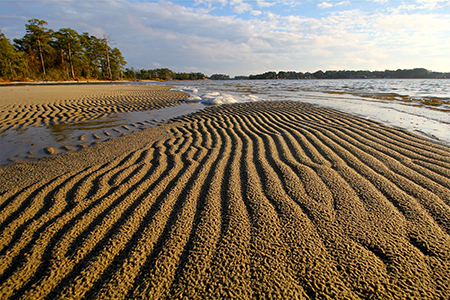
Regular ripples in sand at an ocean beach, Broad Bay, First Landing State Park Virginia, USA.
Photo: vastateparksstaff
Permission: Creative Commons Attribution 2.0 Generic license.
Fauna
Data in this table derived from Woldřich (1893)
| Gudenushöhle Fauna | ||
|---|---|---|
| Taxon | Common Name | Comments |
| Mammalia There are 1 500 bones in total, with reindeer and horse the most common |
||
| Hominins | ||
| Homo sp. | Human remains | Lower canine with a root, belonging to a child. |
| Chiroptera | ||
| Chiroptera | Bats | Circa 100 limb bones belonging to at least three forms. |
| Insectivora | ||
| Sorex araneus | Common Shrew | One lower jaw. |
| Sorex pygmaeus | Eurasian pygmy shrew | Two lower jaws, according to Hacker. |
| Carnivora | ||
| Panthera spelaea | Eurasian Cave Lion | A juvenile canine tooth. |
| Lynx lynx | Eurasian lynx | Parts of an ulna, radius, tibia, calcaneus, and a metatarsus. All these bones came from one young individual. |
| Canis lupus | Wolf | The finds include a lower jaw with teeth, an atlas, two epistrophei (dens axis, odontoid bone), twelve incisors and molars, two Metacarpi II and one IV, one Metatarsus V and IV, two Metatarsi II, all scarcely longer than the bones of a recent dissected skeleton in the Hofmuseum, but a little bit stronger. |
| Canis suessii, Lupus suessii | Type of wolf | The record includes only an Ulna. |
| Canis lupus spelaeus | Cave wolf | The cave wolf is an extinct subspecies of wolf that lived during the Late Pleistocene Ice Age. It inhabited what is now modern-day western Europe. The record here includes two lower jaws, canines, meat teeth and a calcaneus (heel bone), a total of 8 pieces. |
| Canis ferus mikii | Small dwarf-like wild dog, about the size of a jackal. | The record includes two lower jaw fragments with meat teeth and cuspids, described by Hacker as being from Canis familiaris, one palatal fragment with both upper jaws, with p3 on both sides. |
| Canis hercynicus | Small dog | Includes a left subcutaneous fragment with p3, p2, p1, with a Dens sectorius and the front cuspid teeth. The species name hercynicus relates to the Hercynian Forest region of southern Germany. |
| Cuon alpinus europaeus | European dhole, a species of wild dog | This animal became extinct in much of Europe during the late Würm period. The record includes a calcaneus (heel bone) and an astragalus (ankle bone). |
| Vulpes vulpes vulpes | Red fox | The record includes lower jaw fragments, teeth and limb fragments, in total 37 pieces. The red fox is the most abundant and most widely distributed species of Vulpes. |
| Alopex lagopus | Arctic fox | 33 pieces of the lower jaw and fragments of the extremities were found. The Arctic fox is a small fox native to the Arctic regions of the Northern Hemisphere and common throughout the Arctic tundra biome. It is well adapted to living in cold environments, and is best known for its thick, warm fur that is also used as camouflage. |
| Crocuta crocuta spelaea | Cave hyena | The record includes two lower jaws, one canine, two molars and two metacarpal bones. The cave hyena, now extinct, ranged from the Iberian Peninsula to eastern Siberia. |
| Mustela erminea | Ermine or stoat | There is a lower jaw and a canine. |
| Mustela krejcii | Species of weasel | There is a humerus of this form, which lies between the ermine and the little weasel. |
| Martes foina | Beech marten | Two mandibles and a femur, together with a metatarsal and metacarpal bone occur in the deposits. However these may well be relatively modern, given the history of the species, which only appeared in Europe in the Late Pleistocene or the early Holocene. |
| Martes foina | Beech marten | Two mandibles and a femur, together with a metatarsal and metacarpal bone occur in the deposits. However these may well be relatively modern, given the history of the species, which only appeared in Europe in the Late Pleistocene or the early Holocene. |
| Ursus spelaeus | Cave bear | There are two lower jaw, upper jaw and skull fragments, 30 molars, 25 incisors, 21 canines and fragments thereof, limb fragments, in total 120 pieces. Some smaller molars and phalanges may belong to Ursus priscus, the steppe brown bear. |
| Glires Rodents and lagomorphs (rabbits, hares, and pikas) |
||
| Castor fiber | Eurasian beaver | There is an incisor fragment of 7·5 mm width and a distal humeral end. The two incisors mentioned by Hacker were not found when the collection was searched. |
| Glis glis | Edible dormouse | A skull, several lower jaws, and a few teeth belong to this species, for a total of 20 pieces. |
| Lepus timidus | Mountain hare | An incisor, several humeral fragments, a femur, cheekbones and some root bones from the spine, in total nine pieces, were found. |
| Lepus variabilis | Blue hare | These include: lower jaw fragments in 38 pieces, upper jaw fragments 5 pieces, some incisors, 25 cheekbones, 15 humeri, 30 scapula, 20 ulnar fragments, 4 femurs, 15 tibiae, 10 calcanei, 22 pieces of carpal and tarsal bones and two vertebrae. |
| Microtus arvalis | Common vole | A lower jaw of this species was found. |
| Microtus sp. | Vole | Two lower jaw fragments and two femora were found, unable to be identified to species. |
| Dicrostonyx torquatus | Arctic lemming | Two well-preserved lower jaws occur. |
| Cricetus cricetus | European hamster | A lower jaw occurs in Hacker's list, but it was unable to be found in the collection itself. |
| Proboscidea | ||
| Elephas primigenius | Wooly Mammoth | Of this form, only three molar lobes and four root fragments of molars, which originate from the ?Cultural Layer? Culturschichte; furthermore, the pierced one mentioned above belongs here the tusks made button-shaped platelets. |
| Artiodactyla | ||
| Sus sp. | Boar | Two incisors and one canine fragment, both definitely of diluvial (modern) age, a juvenile mandibular fragment and a humerus fragment of a small Sus form, similar to Sus palustris. |
| Ruminantia | ||
| Bos primigenius | Aurochs | A lower jaw fragment and three cheek teeth were found, as well as a radius, an ulnar fragment, the distal end of a tibia and, possibly, six separate molars. |
| Bos taurus | Cattle | Cattle left two metacarpals, a metatarsus, an astragalus, and a phalanx, probably from recent deposits. |
| Capra ibex | Alpine ibex | A well-preserved skull fragment without a facial bone was present, as well as two lower jaw fragments, a mandibular fragment with p3, p2, m1 and m2, and many other bones and fragments. |
| Capra aegagrus | Wild goat | Two mandibular fragments with teeth, a radius fragment, a distal humeral fragment and two phalanges were recorded. |
| Ovis ammon | Argali | The argali, or mountain sheep, is a wild sheep that roams the highlands of Central Asia ( Himalaya, Tibet, Altay ). Included in the collection are a maxillary fragment with three molars. a maxillary fragment with p1, p2 and m1, an inferior m3, a distal humeral half, and a juvenile humerus. |
| Saiga tatarica prisca | Saiga ( extinct species ) | Included in the collection are a mandibular fragment with m1, m2 and m3, three lower m3, and a phalanx I and phalanx II. |
| Capella rupicapra | Chamois | Included here are a forehead and a fragment thereof, both of a very heavy animal, two lower m3, two upper molars, two Calcaneus ( heel bone ) fragments and one possible phalanx II. |
| Antelope sp. | Antelope | There is a small, simply curved, right frontal forehead, which can only be a small antelope. |
| Rangifer tarandus | Reindeer | 35 antler fragments, 20 lower jaw and maxilla fragments, 300 teeth, two pelvic fragments used as small bowls, as well as many other bones. |
| Capreolus capreolus | Roe deer | There are two frontal bone fragments with foreheads of adult individuals, as well as a possible juvenile frontal bone fragment of this species. |
| Cervus elaphus | Elk or wapiti | Key morphological differences that distinguish C. canadensis from C. elaphus are the former's wider rump patch and paler-hued antlers. Remains from Gudenushöhle include: a metacarpus, a humeral fragment, phalanges and other fragments, for a total of 9 pieces. |
| Perissodactyla Perissodactyla is a group of herbivorous mammals characterised by the possession of either one or three hoofed toes on each hindfoot. They include the horses, asses, zebras, tapirs, and rhinoceroses. |
||
| Equus ferus ferus | Tarpan | Also known as the Eurasian wild horse, the Tarpan was a subspecies of wild horse. It is now extinct. The collection includes four molars, limb bone fragments and phalanges, for a total of 30 pieces. |
| Equus fossilis minor | (literally) Small wild horse | Woldřich (1882) equates this to the modern domestic horse, Equus ferus caballus. The collection includes 12 pieces of teeth, mandibular and maxillary fragments, limb fragments and phalanges, giving 66 pieces altogether. As well, there are more than 100 pieces of broken teeth belonging to Equus, 30 pieces of root bones and 20 pieces of various bone fragments. |
| Coelodonta antiquitatis | Woolly rhinoceros | There are three molars with thick enamel, and a fragment of a fourth molar. |
| Aves There are 900 bones of birds in total. |
||
| Raptores This order of birds includes all the birds of prey. |
||
| There are three skeletal fragments of unidentified raptors. | ||
| Order Passeriformes, Suborder Passeri (songbirds or oscines) This group contains approximately 5000 species. |
||
| Turdus merula | Common blackbird | One torso metatarsus was found. |
| Cinclus cinclus | White throated dipper | A torso metatarsus. |
| Loxia sp. | Crossbill | One extremity bone is very close to Loxia curvirostra, the red crossbill. In addition, two extremity bones (including a torso metatarsus) have the size and shape of the bones of Regulus regulus, the Goldcrest, and three others are of three major songbird forms. |
| Galliformes | ||
| Tetrao lagopoides? | Eurasian Black Grouse | The collection includes an ulna and a sternum. |
| Lagopus lagopus albus | Ptarmigan | Included here are two pieces of extremity bones and two sterna. |
| Lagopus lagopus | Willow Grouse | There are three pieces of ulnae. |
| Lagopus muta | Rock Ptarmigan | There are over 40 pieces of limbs and other skeletal bones, including 7 humeri, 4 Sterna, 1 Radius, 7 Metacarpi, 17 Coracoidei and 6 Humeral Fragments. In addition, there are 5 bone fragments belonging to Lagopus sp. |
| Perdix cinerea | Partridge | Three pieces of limb bones were recorded. |
| Gallus sp. | Chicken | From a small chicken form, which is close to the domestic chicken, there are two ulnae, and a skull fragment and a pelvis were found. |
| Natatores This order of 'swimmers' comprises a number of birds which are as at home in the water as upon the land. In all cases the toes are webbed to a greater or less extent. |
||
| Anas crecca | Eurasian teal or common teal | Two extremity fragments were found. |
| Amphibia |
||
| Anura Frogs |
||
| Rana und Bufo sp. | Frogs and toads | 10 pieces of limb bones were found. |
Additional text in the table above from Wikipedia.
Plate 1
Nos 1 - 8: these Magdalenian blades are flat, thin, and elongated, with parallel edges, some of which (1, 2, 3, 4, 5, 8) have had one edge dulled for use as a hand held knife.
Nos 6 and 7 are microperçoirs, miniature drills, which represent the microlith types of the Magdalenian.
Nos. 9, 10, 11, 12, 13, and 14 are simple blades without any retouching, but they characterise the real Upper Palaeolithic, with their prismatic form, their thinness, and their parallel margins, which are especially marked on nos. 11, 12, and 13. The same applies to the blade, No.15, reworked into a burin by just two powerful strokes.
( note that number 9 has been identified by the Natural History Museum Vienna as being a Levallois point, see the image further up this page. I think the Museum has it right - Don )
Photo and text: Obermaier und Breuil (1908)
Plate 2
This image contains only upper Palaeolithic blades which have undergone further processing, either by simple retouching or by direct transformation into new types.
Nos. 1, 2 and 3 are lateral burins, where only the right side actual engraving edge is made by a single simple blow; the left is formed in the three examples shown by an oblique, strong retouching.
No. 6, again, is a simple burin of the sort of Fig. 15 in plate 1, but rather clumsy. Nos. 4, 5, 7, 9, 10 and 14 are typical representatives of Magdalenian scrapers, characterised by more or less round 'thumbnails' retouched on the upper end of the blade.
No. 8 is a blade with upper rectilinear transverse retouching and the right-sided No. 11 is a long blade with strong traces of use on the left margin.
No. 12 is a large drill, No. 13 a cutting tool, its right edge in its lower half is a handle - this area was greatly dulled to suit this purpose.
These artefacts shown accompany a number of nuclei, as well as a large amount of debitage. The flint material seems to have been particularly appreciated,
( it may have been in short supply, and/or have come from a considerable distance - Don ) which is why it was sparingly used and exploited judiciously.
There were some quartz river pebbles present which were quite burnt, and were probably used as cooking stones ( or for heating liquids - Don ).
Photo and text: Obermaier und Breuil (1908)
Plate 3
Bone and antler tools are also particularly characteristic of the Gudenushöhle Magdalenian. For this reason we have put them together here on plate 3.
No. 1: Large bird radius, 149 mm long, with decorative incisions on all sides. The middle of the piece carries a drawing, which we show unrolled below. The design strikingly interrupts the vertical lines, so that we are inclined to see in the design an intentional representation of a reindeer. The piece is best explained as a decorated Needle holder. In the Grotte du Placard (Charente) a similar specimen was found (unfortunately smashed) that contained a number of fine needles in its interior. A related 'bone bottle', which still contained powdered ochre, was found in la grotte des Cottés (Vienne).
No. 2, 3, 4, 5, 6, 14: Fine needles of antler or bone.
No. 7: bone awl.
No. 9: Bone chisel, much worn at the lower end.
( These were used to split or snap antler and bone after preparatory grooves were made with a burin, a faster and easier method than trying to cut the article right through - Don )
10, 16, 20; Spearheads with doubly bevelled bases and deep longitudinal 'blood grooves' on the broad sides.
Text in italics below adapted from https://bshistorian.wordpress.com/2008/06/05/the-blood-groove/
'Blood grooves' are now thought to have no effect on allowing a spear point or sword to enter prey or a battle combatant, nor does it make it easier to withdraw the weapon. In metal swords and spear heads they may be used to lighten the weapon without sacrificing any strength.
Nos. 12, 15, 18, 19: varieties of spearheads, some with decorative engravings.
Nos.11, 13: Bone fragments with decorative patterns. (No. 13 from bird bones, as is common in Magdalenian artefacts.)
Nos. 8, 17: Pierced teeth of deer and fox.
No. 21: Reindeer antler, pierced by an oval hole. This piece undoubtedly is one of the many Magdalenian pierced batons. (Length: 190 mm.).
Other jewellery and trinkets include: animal teeth, amber and red ochre, a Dentalium fossil shell, two examples of Ancillaria glandiformis (now Baryspira glandiformis), a fossil 'olive snail', with artificial cuts, and a Cerithium (fossil mollusc).
Partially 'unrolled' reproduction of an engraving on a needlecase from the Gudenushöhle, from the later Magdalenian deposits.
Photo: Obermaier und Breuil (1908)
A photograph of the needlecase from the Gudenushöhle, from the later Magdalenian deposits.
Needlecases were made from bird bones, which are hollow, and are convenient receptacles for bone and ivory needles for sewing leather.
Photo: Obermaier und Breuil (1908)
Fauna
Magdalenian layer:
The bones are little decomposed, fresh in appearance and usually of a light yellow colour. The great majority are the remains of Rangifer tarandus (Reindeer) and Lepus variabilis (Mountain Hare), as well as Antilopa Saiga (?) (Saiga Antelope), Capella rupicapra (Chamois), Cervus elaphus (Red Deer) and Equus caballus (horse, a smaller breed).
Pre-Magdalenian layer:
Black-brown and blackish bones, with numerous traces of erosion, a little damaged and with a shiny appearance.
Here we find: Cervus elaphus (Red Deer) and Canis lupus (Wolf).
Mousterian Layer:
The bones have suffered damage from being tumbled, thus suffering severe damage, sometimes at the very least quite scuffed, and often gnawed by Hyenas.
The fauna are divided into: Hyaena spelaea (Cave Hyena), Ursus spelaeus (Cave Bear), Elephas primigenius (Wooly Mammoth), Rhinoceros tichorhinus (Wooly Rhinoceros), Bos primigenius (Aurochs), Capella rupicapra (Chamois), Rangifer tarandus (Reindeer) (in small quantities) and Equus caballus (Horse, larger breed).
In all cases, the pieces have been subjected to water tumbling, since they have scouring scratches from sand over almost all their surface.

As samples from the deepest non-sterile level, we present three bone fragments. They are apparently damaged by human hands, since the fracture of these very strong bones could only be brought about by violent blows. This could not have come about through damage by falling rock, given the local conditions in the cave.
1. Bone fragment, with strongly abraded edges and spongy mass evident.
2. Bone fragment, very irregularly trimmed, heavily 'rolled' on all corners and edges, with numerous surface scratches from sand.
3. Bone fragment, with numerous gravel scratches and gnawing marks at the bottom.
Photo and text: Obermaier und Breuil (1908)
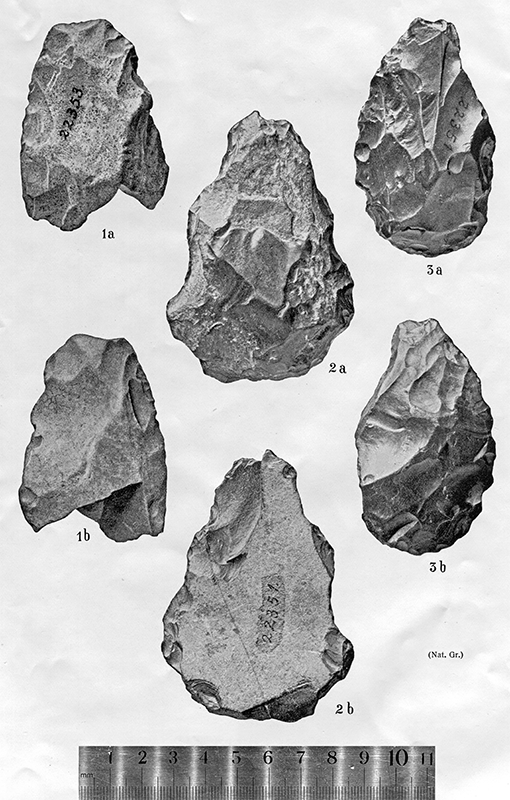
Plate 4
Rolled Artefacts Group, double-sided types.
No. 1a and 1b: Ovoid handaxe, deeply patinated and with heavily rolled edges. The piece is broken at the base, and this fragmentation has taken place relatively recently, as the fracture surfaces are sharp and not worn.
However, because they have at least a renewed patina evident, it is likely that the piece came to the surface in Magdalenian times, and was broken by the cave dwellers of those times.
A parallel for such a reading of ancient Palaeolithic tools in the early Palaeolithic period is provided specifically at the classic site of Laugerie-Haute in the Dordogne. Just as in the Gudenushöhle, the reindeer hunters had to resort to deposits of deposits.
In some places deeper layers have been dug up, and thus we encounter older inclusions in later deposits. The median section of the above specimen is quite irregular, the surface treatment raw, of the 'Chelléen' ( now referred to as Acheulean - Don ) type.
Quartzite, thickness 21 mm, maximum width 52 mm, maximum height 75 mm.
2a and b: Somewhat 'flattened' hand axe, made from a rather thin piece of chert. The underside is less retouched and retains the larger part of the natural surface, the edges are steeply retouched. (Height 97 mm, width 68 mm, thickness 21 mm.)
3a and b: Ovoid handaxe, a little stretched. On the front side is a very regular, semi-curved edge retouched on the left edge; the opposite right margin is left thick and unretouched, so the specimen apparently must have served as a convex scraper. This piece, which possesses the genuine 'almond shape' of Saint Acheul, and also has the advanced shaping related to it, seems to have been strongly heated; it has obvious fissures, with several small circular conchoidal scars discernible on the top and bottom. (Jasper, height 85 mm, width 50 mm, thickness 21 mm.) Photo and text: Obermaier und Breuil (1908)
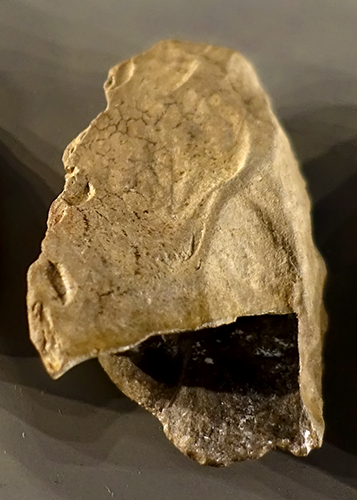
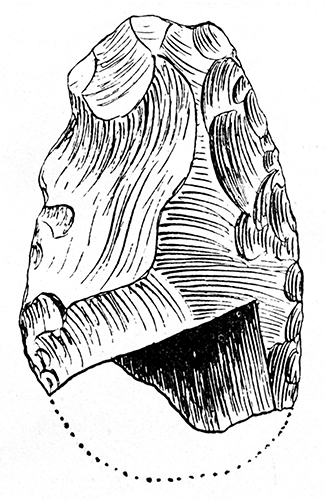
This shows (left) the original broken ovoid handaxe and (right) the drawing of the tool from the same viewpoint, as in 1b above, with the completion of the tool as first made.
Photo (left): Don Hitchcock 2018, Original, Natural History Museum Vienna, Naturhistorisches Museum Wien
Photo (right): Obermaier und Breuil (1908)
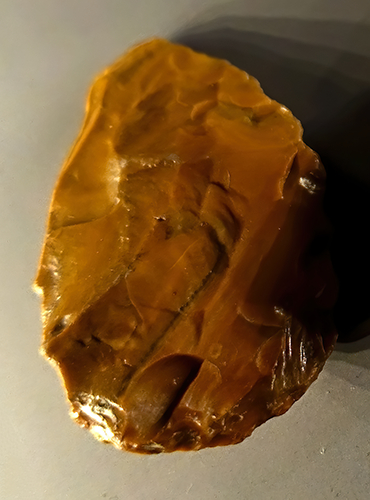
Jasper ovoid handaxe as in 3b above.
Photo: Don Hitchcock 2018
Source: Original, Natural History Museum Vienna, Naturhistorisches Museum Wien
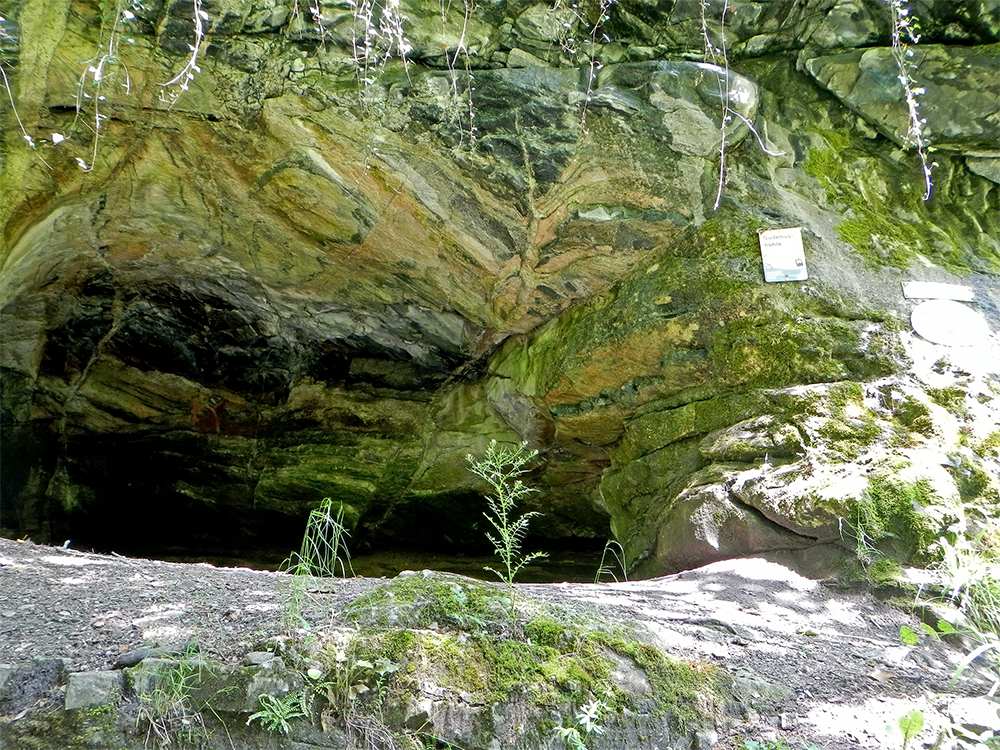
Gudenushöhle entrance
Photo: Schurdl
Permission: Creative Commons Attribution-Share Alike 3.0 Unported license
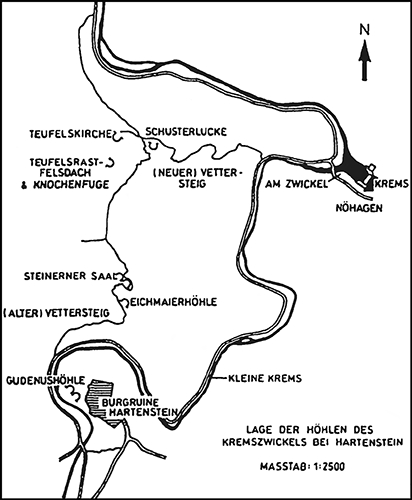
Location of Gudenushöhle.
Photo: Galik (1997)
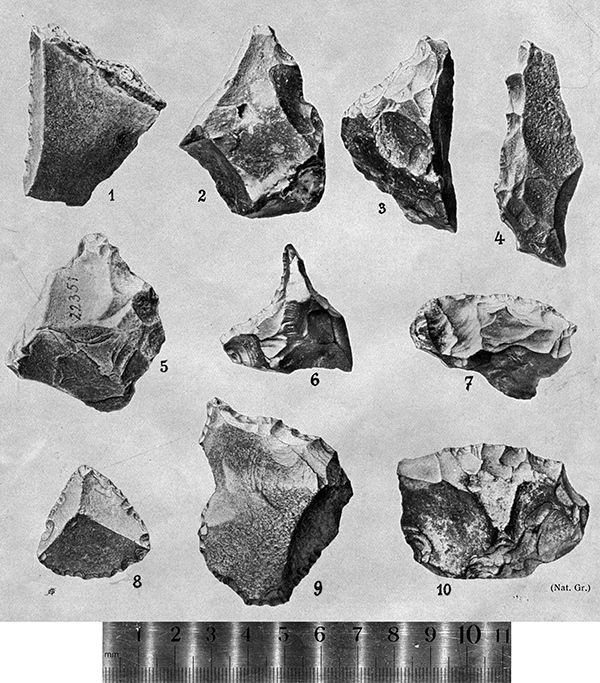
Plate 5
Artefacts of amorphous shape.
These comparatively numerous stone pieces are without a clearly defined shape or form or use, whether naturally broken or broken by man. They represent 'eoliths', and accompany every primitive workshop.
1: Chert fragment - a purely natural fragment - and without actual retouching, but with clear signs of use, especially on the left margin.
2: Very thick, shapeless chert fragment, with retouching on a blunt tip. Retouching is likewise found on the other edges, but can only be seen, in this image, at the top right.
3: Less rolled natural debris, chert, with oblique retouching on the top left, with the form of a kind of oblique scraper (racloir oblique).
4: Narrow chert fragment, perhaps a fragment of a formerly much larger artefact of the form of Fig. 2, plate 4 above, and again severely rolled after fragmentation. The left-hand edge carries strong, almost vertical, steep retouching and finishes at a thick tip.
5: Natural chert fragment of irregularly discoid form, with small areas of uneven patina, suggesting a successive retouching of the piece; nevertheless, all edges are abraded. The object ends in a blunt tip; the right margin is repeatedly retouched on the upper as well as the lower surface, the left projecting edge reminds one of a thickened scraper, which is not apparent in the photograph. All in all, this is a repeatedly and heavily used fragment.
6: Natural fragment of flint with fairly worn edges, shaped into a drill (perçoir).
7: Natural fragment of jasper, with a semi-arched edge at the top, bearing the typical scraper-like retouch.
8: Triangular chert fragment with retouching on all edges.
9: Natural, rather shallow piece of chert, retouched on all edges on the upper side, resulting in a kind of oblique scraper, and ending in a drill on the left hand side. The inner edge is partially retouched on the underside, resulting in a notch.
10. Very rolled flint piece, made into a typical scraper, the lower, thickened edge being specially treated to form a gripping area by several retouches.
Photo and text: Obermaier und Breuil (1908)
Plate 6
Single sided types.
The pieces to be described here are consistently made of intentionally struck flakes, which have the characteristic shapes, striking surfaces, and conchoidal impact scars of the Mousterian lithic tradition.
1: Round quartzite flake; below, at the base, provided with a deep, improved grip surface, and on the edges of all sides are traces of wear.
2: Trapezoidal, very thick jasper flake with signs of usage at the edges.
3: Elongated, thick chert flake, retouched on the left longitudinal edge on both sides, above and below.
4: Triangular ( in cross section - Don ) flint flake, heavily retouched on the right side to create a slanted point and with numerous smaller retouches on the left side. The specimen has been burnt red by fire and shows two conchoidal scars on the upper side shown.
5: Mousterian point of flint, with well retouched converging edges and careful retouching at the base.
6: Ovoid chert flake, rather thick and very rolled, with typical impact bulge underneath; at the base retouching to neaten the edge. The inner edge forms a typical convex scraper that ends in an oblique burin point. The right edge is well retouched towards the top.
7: Ovoid crude scraper in white-grey slate, but with careful retouching to form a curve at the top.
8: Part of a quartzite pebble. The middle surface of the upper side is reminiscent of a discoidal Mousterian core, shown by the negative of a wide flake. The two well retouched margins are designed to act as scrapers. The back still has the convex, natural pebble surface.
Of the group described above, a second one stands out, likewise composed of old, patinated pieces, which, however, have not been rolled.
After all, among them are often specimens that have at least some worn edges and corners. Thus the separation between the first and second groups can not be made with absolute accuracy.
Photo and text: Obermaier und Breuil (1908)
Plate 7
Second group: Unrolled artefacts. Types which have been knapped on both sides.
1: Heart-shaped (cordate) handaxe of Quartzite. The surface finish of the front side is quite rough, even minor edge retouching is missing. Noteworthy is the flat grip ('méplat') on the right side edge, formed by a 6 cm long, intentionally shaped flat surface. The reverse side of the piece has been broken off to a large extent as a result of a horizontal flat fracture, either during the course of excavation or, more likely, as a result of the action of fire, which can also be seen on the left corner of the front by the strong reddening of the stone there. Height 96mm, maximum width 87mm, maximum thickness 32mm.
2: Ovoid chert handaxe. The surface treatment of the heavily curved front is meticulous. The edge of it is especially finely retouched, which suggests its purpose as a scraper. The lower end has been broken off since ancient times. The back is retouched only on the left half, so that this artefact might have been unfinished. Height 101 mm, width 62 mm, thickness 35 mm.

3: Ovoid chert handaxe fragment. From the front, only the left hand side well retouched margin is preserved, while the middle and right edges have been largely destroyed, possibly by fire. Height 90 mm, width 52 mm, thickness 27 mm. See Fig. 8.
Photo (reconstruction) and text: Obermaier und Breuil (1908)
4: Ovoid chert handaxe in side view, placed on the 60 mm long, flat grip surface of the right side edge. The left margin reproduced here has only a very irregular, raw cutting edge. Height 84 mm, width 50 mm, thickness 33 mm.
5. Heart-shaped chert handaxe, quite arched on the top surface, knapped rather flat on the lower surface. This piece is reminiscent of Plate 4, No. 2, is a bit worn and could also belong to the first group. Height 80 mm, width 59 mm, thickness 27 mm.
6: Quartzite handaxe fragment in side view, placed on the flat grip surface of the right side margin, which is 50mm long; the left margin again forms a very irregular cutting edge. Height 69 mm, width 44 mm, thickness 29 mm.
Photo and text: Obermaier und Breuil (1908)
Plate 8a and 8b
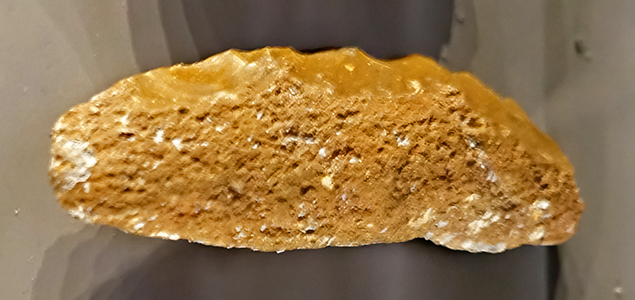
Plate 8a and 8b
Nos. 1a and 1b: Scraper of jasper, made of a long, narrow, natural silica nodule, whose crust was left intact on the lower edge as a grip surface. Scraper retouch has been worked on the upper edge of both the front and the back. Length 96 mm, width 33 mm, thickness 23 mm.
Photo: Don Hitchcock 2018
Source: Original, Natural History Museum Vienna, Naturhistorisches Museum Wien
B/W Photo and text: Obermaier und Breuil (1908)
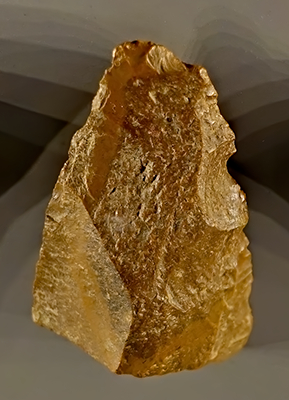
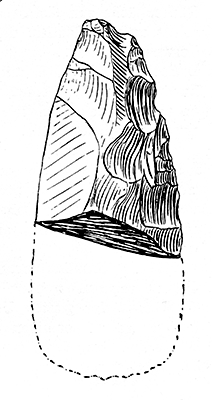
Plate 8a and 8b
Nos. 2a and 2b: Fragment of the upper half (tip?) Of a chert handaxe, possibly of a very elongated, lance-like shape. The base is quite flat. Height 75 mm, width 43 mm, thickness 22 mm.
( note that this artefact has been identified by the Natural History Museum Vienna as being a scraper. Note also that the artefact has a large notch on the right hand edge in this image, consistent with it being used to shape bone spear points or similar. I think the Museum has it right, it is not a handaxe, but a scraper - Don )
Photo (left): Don Hitchcock 2018
Source: Original, Natural History Museum Vienna, Naturhistorisches Museum Wien
Photo (right, reconstruction) and text: Obermaier und Breuil (1908)
Nos 3a and 3b: small jasper handaxe of triangular, pointed shape. The careful retouching of the margins is reminiscent of the type and the methods of 'La Micoque'. At the bottom, only the right side margin is retouched. Height 59 mm, width 44 mm, thickness 18 mm.
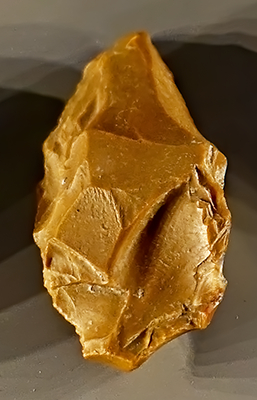
Plate 8a and 8b
Nos. 4a and 4b: Very small jasper handaxe, analogous to No. 3, but even narrower. The left side edge of the top forms a convex side-scraper, on the underside at the same place it is finely retouched. Height 56 mm, width 26 mm, thickness 14 mm.
( note that this artefact has been identified by the Natural History Museum Vienna as being a scraper. It is a bit of a stretch to call something less than 6 cm long a handaxe, and especially when one edge 'forms a convex side-scraper' according to Obermaier und Breuil (1908). In addition, the face shown here has not been retouched to form the standard relatively 'smooth' face of a handaxe. I think the Museum has it right, it is not a handaxe, but a scraper - Don )
Photo: Don Hitchcock 2018
Source: Original, Natural History Museum Vienna, Naturhistorisches Museum Wien
B/W Photo and text: Obermaier und Breuil (1908)
Nos. 5a and 5b: Right-handed jasper scraper, whose two-sided, rather rough surface treatment mimics handaxe working. At the top is very well retouched scraper blade of almost horizontal alignment; the arched grasping area is intentionally trimmed and improved. Length 73 mm, width 43 mm, thickness 24 mm.
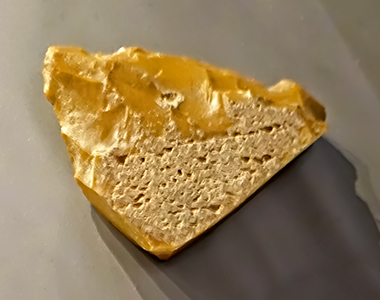
Plate 8a and 8b
Nos. 6a and 6b: Scraper, made from a rather thin and flat flint fragment, with broad faces retouched on both sides. Length 63 mm, width 48 mm, thickness 14 mm.
Photo: Don Hitchcock 2018
Source: Original, Natural History Museum Vienna, Naturhistorisches Museum Wien
B/W Photo and text: Obermaier und Breuil (1908)
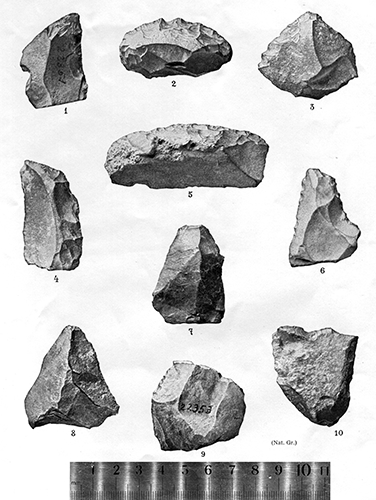
Plate 9
Artefacts made from amorphous flakes
The flakes may be either purely natural or intentionally generated fragmentation products.
No. 1: Thin, natural flake with fine retouching on the rectilinear right margin.
No. 2: Thick flake which carries on its upper, curly edge a typical scraper retouch. In addition, the left half of the lower edge of the upper side has retouching, while the flat underside carries no trace of retouching. This is of a typical Mousterian type.
No. 3: Thin, trapezoidal flake, with retouching at the two upper convergent edges, which thus found use as a scraper.
No. 4: Thick flake, with retouches to create a grip along the entire thickened, arcuate right edge. The linear left cutting edge is very thin and has some retouching. The basal surface is also artificially dressed.
No. 5: long narrow flake; the upper thickened edge of the front side forms a typical scraper with a convex arc cutting edge, but was also considered as a back surface for gripping the piece since the thin edge of its lower edge, carrying retouches was used as a knife.
No. 6: Triangular flake, with fairly rounded edges, so that the specimen could also belong to the first group. It has retouching on all cutting surfaces and a kind of concave scraper notch on the right side edge.
One-sided edited artifacts
The pieces are all made from intentionally knapped flakes and mostly of standard Mousterian type. According to their shape, some of the flakes could just as well have belonged to the Magdalenian horizons: for the classification of the objects in this plate, their patina was decisive.
Simple basic forms.
No. 7: Quartzite flake, without further retouching, with strongly rounded edges; the edges of the smooth underside are sharp-edged, the color pale, in contrast to the top, which has been rubbed smooth. The allocation of this piece to the Magdalenian period is not excluded in view of these peculiarities.
No. 8: Triangular fragment of chert, with scraper retouching on the converging right cutting edge; the retouching is on the underside, on the right corner.
No. 9: Very patinated slate flake, with light scraper retouch in the upper part of the left
edge.
No. 10: Thin flat jasper flake, with a fine, straight scraper retouching on the right side edge. The upper extremity on the right corner is damaged by a modern break.
Photo and text: Obermaier und Breuil (1908)
Plate 10
No. 1: Chert scraper. Fragment of a large specimen, similar to Plate 9, No. 5, but of all intentional knapping. Thickness 16 mm.
No. 2: Very irregular quartzite scraper; the right corner at the top is a kind of burin. Thickness 19 mm.
3: Typical scraper struck from a natural flint fragment, but all facets of the face shown are artificially created. The apparent retouches at the bottom of the image are due to a modern blow from a pickaxe. Thickness 19 mm.
No. 4: Small quartzite double scraper. Scraper retouch at the top and bottom of the front surface; the left side edge forms a kind of primitive burin.
No. 5: Fragment of a small flint blade, with retouching on the upper and lower margin and on the left margin. Very worn, with traces of exposure to fire.
No. 6: Thick quartzite scraper. Thickness 18 mm.
No. 7: Small chert point, with a curved, steeply retouched left edge and a straight right edge, so that a kind of knife with a broad dull back was created. Almost worn out.
No. 8: Irregular quartzite primitive blade, very worn and patinated. The upper and lower extremities are retouched to form a scraper. Thickness 6 mm.
No. 9: Triangular flint scraper, retouched on the two upwardly converging edges ('racloir angulaire'). Thickness 20 mm.
Photo and text: Obermaier und Breuil (1908)
Plate 11
These artefacts are of hyaline quartz/rock crystal.
These short, thick artefacts are very different from the Upper Palaeolithic artefacts especially typical of the Žitný-Höhle in Moravia, which are thin, fine lamellar flakes and made from the same brittle material.
No. 1: Small handaxe made of quartz, knapped on both sides, with heavily worn edges. Height 46 mm, width 36 mm, thickness 19 mm.
No. 2: Short, very thick tip, retouched on the two converging edges, at the top of the upper side and partly on the left edge of the lower. (Nos. 1 and 2 may also belong to the lower level),
No. 3: Fine, bifacially worked rock crystal point; stretched ovoid; slightly thickened on the left margin, a 'miniature handaxe'. Height 37 mm, width 20 mm, thickness 10 mm.
No. 4: Thick triangular flake, with the usual retouching on all edges and two concave kerfs or grooves towards the thick tip.
No. 5. Drill, made at the top of a rough flake, with alternating over and under retouching.
No. 6. Sparsely retouched Handspitze, rather thin. The Handspitze, or hand point, (also Mousterian point), is a flat, mostly oblong, sometimes wide and squat, large flake with a flat, mostly triangular cross-section.
( this text from German Wikipedia - Don )
No. 7: Stubby triangular point; for the converging edges, the right and left sides are retouched on the front and back.
No. 8: Short blade, retouched at the tip.
No 9: Thick short flake, with abrasion of the retouching on all edges; on the upper edge two small notches, with a drill point between them.
No 10: Ovoid flake, with a convex scraper retouch on the left margin.
No. 11: Triangular flake, with a flat base and retouching on the remaining edges.
No. 12: Thick triangular flake with a well retouched projecting tip.
No. 13: Small triangular point, rather thin, with very good retouching on the two margins forming the point.
Photo and text: Obermaier und Breuil (1908)
From a full examination of this inventory, it can be established with undoubted certainty that the Gudenushöhle was already inhabited by man when the thick rippled sand layer of the base was deposited, or towards the end of its formation.
Various floods forced the then settlers to repeatedly temporarily abandon the cave, possibly because of the periodic rise in level of the internal springs, which had washed out the fissure cave ( i.e. one formed by tectonic forces - Don ), which itself was about 8 metres higher in altitude than the level of the former Krems River.
This settlement continued after the grotto was completely drained, and appears to have become even more intense, judging by the greater number of artefacts.
The stone tool inventory originating from this epoch forms a decidedly old Palaeolithic Horizon where we have to distinguish a lower level with rolled artefacts and an upper level with old, patinated, unrolled artefacts.
Significant typological differences do not occur at these levels. One can only say that the stone types of the upper strata become somewhat more distinct and numerous, and that thus there has been a certain improvement of the lithic industry.
This is especially proven by the much finer handaxes and the numerous good types of scrapers. This level of the Gudenushöhle layers are particularly interesting for the fact that they were at this time the richest handaxe deposits in Central Europe.
It is obvious from even a cursory inspection that there is only a small percentage of medium sized handaxes, and in fact most are only of a small size. However this is directly due to the shortage of larger silica nodules available in the deposits close to this area. Nevertheless, this biface inventory is typical, as evidenced by thousands of parallel copies from Western Europe.
The question of its closer classification as part of the Old Palaeolithic frame can be decided by the fact that there are certainly Acheulean types. The rough types represented could be regarded as Chelléan as well as early Mousterian.
For the former, there is no faunal clue, so we decide in the latter sense and assign them to the Mousterian horizon, which is very well represented by types knapped on only one side.
We would therefore like to call the lower palaeolithic layers of the Gudenushöhle Acheulean - Mousterian, whose finer separation is no longer possible for us today; the companion fauna of this industry formed, perhaps at first, Hyaena spelaea, Ursus spelaeus, Elephas primigenius, Equus caballus, etc., and perhaps later, Rangifer tarandus and Capella rupicupra, or cave hyenas, cave bears, wooly mammoths, horses, and perhaps later reindeer and chamois.
But it was not until much later that the cave was visited by anatomically modern humans, who left us with the relics of the Magdalenian, which had hitherto been the only deposits known and excavated.
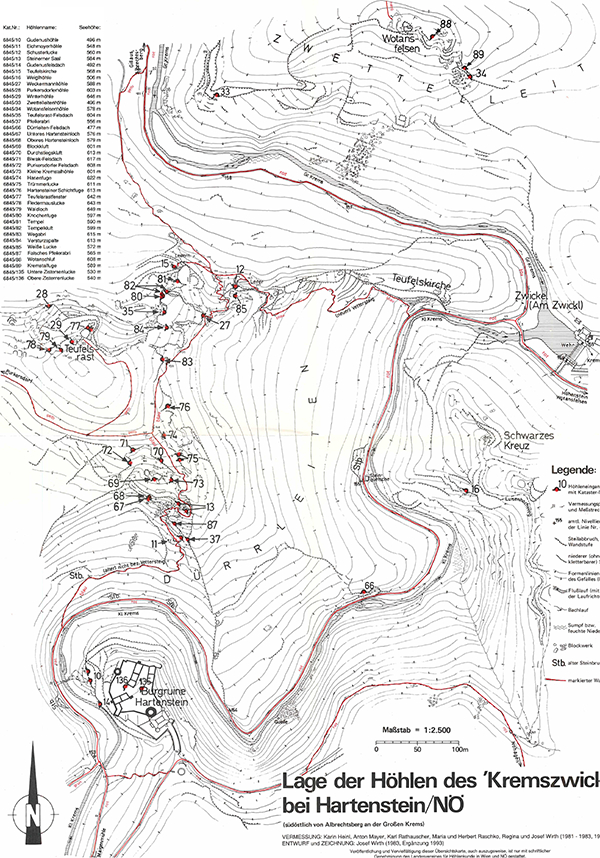
Map of caves in the area of Gudenshöhle, which is number 10 on the map, just to the west of the castle ruin.
Photo: Mayer et al. (1993)
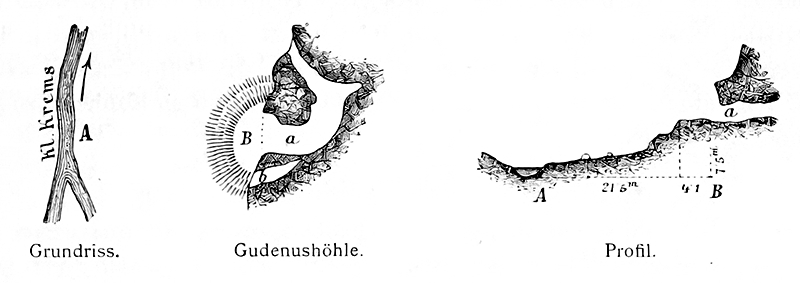
Plan and profile of the Gudenushöhle.
Photo: Woldřich (1893)
This cave, which I visited in the company of Mr. Ferdinand Brun, formerly had no special name and was called by the first discoverers Gudenushöhle in honour of the landowner, Imperial Baron Henry V. Gudenus.
Father Leopold Hacker published in 1884 a preliminary report on this cave, in which a provisional list of the animals found appears, and whose identification, according to the author's confession, was uncertain.
I found notes only on a few pieces of mandible out of all of this rich material, and these often contained incorrect names, so I had to completely ignored this source.
The Gudenushöhle, below the Hartenstein Ruin, 7.5 metres above the valley floor, has two entries, and forms an angled passage of 22 m in length and 2 to 3 metres in width. In front of the southern entrance there is a seemingly artificial forecourt, with steeply sloping walls.
The systematic excavations carried out in 1883 and 1884 revealed that only the larger half of the cave to the south contained remnants of man; in the deposits of the northern half, which was probably artificially barricaded, no such remnants were found.
The layers that covered the site were but little disturbed, and the following layer sequence was observed in the front half of the cave:

1. Recent deposits, consisting of earth, ash, stones and so on. 7 cm
2. Cultural history with artefacts and broken bones. 28 cm
3. Cave soil. 6 cm
4. Cave clay with whole, unrolled bone. 26 cm
5. Cave clay without inclusions. 28 cm
6. Rippled sand. 65 cm
7. Cave clay with boulder inclusions. 22 cm
Photo: Woldřich (1893)
A fairly deep layer found at the southern entrance was not revealed until the excavation; this had been artificially completed against the cave by stone blocks; their fill consisted of charcoal pieces and flint shards under mixed sand, and contained essentially the same artefacts and bone fragments as the cultural layer of the main cave.
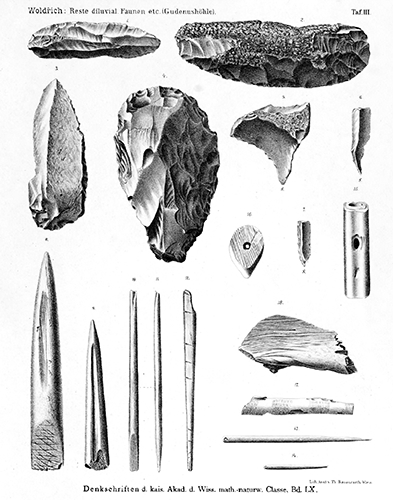
Gudenushöhle, Plate III.
1. Flint knife.
2. Scraper, brown jasper.
3. Spear point, chert.
4. Axe, brown jasper.
5. Roughly made drill made of brown jasper .
6. Fine flint drill.
7. Fine flint drill.
8. Spear point of reindeer antler with poison groove?
9. Spear point of reindeer antler with poison groove?
10. Bone chisel from a fibula, from the front. ( this looks much more like a bone spear point with a double bevel to me - Don )
11. The same, from the side.
12. Bone awl with rounded tip.
13. Bone needle with eye made from the shoulder blade of a reindeer.
14. Bone needle, ( with an eye ), a smaller, broken specimen.
15. Flute made using a tubular ( bird ) bone.
16. Button shaped pierced ivory artefact.
17. Decorated fragment of a bird bone.
18. Fragment of a worked reindeer antler.
Photo: Woldřich (1893)
References
- Ackerl, I., 2009: History of Austria in dates : From prehistoric times to 1804, marixverlag , 20 Feb 2009 - History - 224 pages
- Döppes, D., 1997: Die jungpleistozäne Säugetierfauna der Gudenushöhle (Niederösterreich), Wiss. Mitt. Niederösterr. Landesmuseum, 10, 17-32 Wien 1997
- Galik, A., 1997: Die Höhlen des Kremszwickel im Waldviertel (Niederösterreich) unter, besonderer Berücksichtigung der Schusterlucke, Wiss. Mitt. Niederösterr. Landesmuseum, 10, 7-15 Wien 1997
- Hacker, L., 1884: Die Gudenushöhle, eine Rentierstation im niederösterreichischen Kremstale, Mitteilungen, Anthropologische Gesellschaft in Wien, XIV, 1884, S. 145
- Hartmann, W. & H., 1985: Herausgegeben vom Landesverein für Höhlenkunde in Wien und Niederösterreich, Die Höhle, wiss. Beih. 30: 339-345, Wien.
- Mayer, A., Raschko H., Wirth J., 1993: Die Höhlen des Kremstales, Die Höhle, 33, Wissenschaftliches Beiheft zur Zeitschrift, Wien. Herausgegeben vom Landesverein für Höhlenkunde in Wien und Niederösterreich
- Obermaier, H., Breuil H., 1908: Die Gudenushöhle in Niederösterreich, Wien, Im Selbstverlage der Anthropologischen Gesellschaft, Mit 11 Tafeln und 9 Abbildungen im Texte.
- Szombathy, J., 1913: Untersuchung von Höhlen im Kremstale bei Hartenstein, Niederösterreich. Mitt. der K. K. Zentral-Kommission für Denkmalpflege, 3. Folge, Bd. XII, Nr. 9 (Wien): 135 f.
- Thenius E., 1962: Die Grossäugetiere des Pleistozäns von MitteleuropaZeitschr. Säugetierk, 27: 65-83
- Woldřich, J., 1882: Jahrbuch der Kais. Kön Geol. Reichsanstalt, 32 Band 1882
- Woldřich, J., 1893: Reste diluvialer Faunen und des Menschen aus dem Waldviertel Niederösterreichs, LX. Band der mathematisch-naturwissenschaftlichen Klasse der kaiserl. Akademie der Wissenschaftern. Wien 1893
